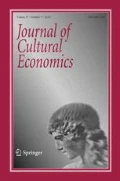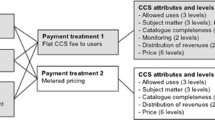Abstract
The protection of copyrights in the music industry has been of paramount concern as the popularity of digital music players, personal websites, and file-sharing continues to grow, each of which subsequently contributes to the persistence of Internet music piracy. While the Recording Industry Association of America (RIAA) links file-sharing to copyright piracy, others argue that file-sharing allows maximum exposure of artists’ music which in turn increases its value. While this debate continues, little empirical research has specifically addressed the behavioral aspects of the consumer. In this paper, we use survey data on university students to study how attitudes toward copyright law along with economic and demographic factors affect the extent of music copyright violations. We find that while students are responsive to economic incentives and perceptions of risk, the extent of these incentives has not reversed the overall propensity to engage in file-sharing.
Similar content being viewed by others
Notes
An abridged version of the survey containing all questions relating to this article is found in Appendix 2.
Though we collected information on students’ majors, initial regression estimates showed that the type of major did not influence patterns of music consumption or how music is acquired. Thus, we do not include this variable in the regression analysis, though we present summary statistics for the purpose of describing the distribution of students surveyed.
Although we ask questions based on file-sharing, CD duplication (music ripping) is also a very common way of “sharing” music. In general, the survey seemed to capture the use of both methods, since the alternative to file-sharing are the legal alternatives. Thus, CD duplication would fall under the same category as file-sharing.
The 2.5% finding was during the 2003–2004 year, when fee-based music services were just starting to develop. This figure is likely to be significantly higher today, though based on industry analysts, not likely to exceed the file-sharing percentage.
The Fairness variable does not appear in Table 2, because Fairness is used in the selection equation for identification purposes. But the effect of Fairness on file-sharing can be observed in the results in Appendix 1. Indeed the coefficient has a negative sign as expected, and is statistically significant at conventional levels for the Probit and Tobit specifications.
The elasticities are readily computed in STATA with the Heckman and MFX procedures.
Since the questions measuring the importance of cost, time, and song selection were only asked of students that admit to file-sharing, we are unable to include these variables in the full regression model estimating the determinants of file-sharing. However, we ran the full model again using the sub-sample of students that answered the question and including the cost, time, and song selection variables. The coefficients for New (percentage of recent music acquired via file-sharing) as follows: Cost: 17.39*** (T-statistic: 3.77); Time: 14.18*** (T-statistic: 3.59); Song Selection: 1.03 (T-statistic: 0.26).
References
Amemiya, T. (1984). Tobit models: A survey. Journal of Econometrics, 24, 3–61.
Apple, Inc, http://www.apple.com/itunes, accessed Jan. 30, 2007.
Becker, G. (1968). Crime and punishment: An economic approach. Journal of Political Economy, 76, 169–217.
Ben-Shahar, D., & Jacob, A. (2004). Selective enforcement of copyright as an optimal monopolistic behavior. Contributions to Economic Analysis and Policy, 3, 1–29.
Besley, D. A., Kuh, E., & Welsch, R. E. (1980). Regression diagnostic: Identifying influential data and sources of collinearity. New York: John Wiley and Sons.
Bhattacharjee, S., Gopal, R. D., Lertwachara, K., & Marsden, J. R. (2006). Impact of legal threats on online music sharing activity: An analysis of music industry legal actions. Journal of Law and Economics, 49, 91–114.
Boldrin, M., & Levine, D. (2002). The case against intellectual property. American Economic Review, 92, 209–12.
Butler, A. H. (2000). The doctrine of universal jurisdiction: A review of the literature. Criminal Law Forum, 11, 353–73.
Cameron, S. (1988). The economics of crime deterrence: A survey of theory and evidence. Kyklos, 41, 301–23.
Cheng, H. K., Sims, R. R., & Teegen, H. (1997). To purchase or pirate software: An empirical study. Journal of Management Information Systems, 13, 49–60.
Chiang, E. P., & Assane, D. (2002). Software copyright infringement among college students. Applied Economics, 34, 157–66.
Cox, D., & Jappelli, T. (1990). Credit rationing and private transfers: Evidence from survey data. The Review of Economics and Statistics, 72, 445–54.
Dudley, L., & Montmarquette, C. (1976). A model of the supply of bilateral foreign aid. American Economic Review, 66, 132–42.
Gayer, A., & Shy, Oz (2005). Publishers, artists, and copyright enforcement. University of Haifa Working Paper.
Gopal, R. D., Sanders, G. L. (1998). International Software Piracy: Analysis of Key Issues and Impacts. Information Systems Research, 9, 380–97.
Heckman, J. (1976). The common structure of statistical models of truncation, sample selection and limited dependent variables and a simple estimators for such models. Annals of Economic and Social Measurement, 5, 475–92.
Heckman, J. (1979). Sample selection bias. Econometrica, 41(1), 153–61.
Hinduja, S. (2006). A critical examination of the digital music phenomenon. Critical Criminology, 14, 387–409.
Hoffman, D. L., Novak, T. P., & Venkatesh, A. (2004). Has the internet become indispensable? Communications of the ACM, 47, 37–42.
International Federation of the Phonographic Industry (2006) The Recording Industry 2006 Piracy Report: Protecting creativity in music, http://www.ifpi.org/content/library/piracy-report2006.pdf, accessed Jan 15, 2007.
Lam, C. K., & Tam, B. C. (2001). The internet is changing the music industry. Communications of the ACM, 44, 62–68.
Liebowitz, S. J. (2006). File sharing: Creating destruction of just plain destruction? Journal of Law and Economics, 49, 1–28.
Leung, S.-F., & Yu, S. (1996). On the choice between sample selection and two-part models. Journal of Econometrics, 72, 107–28.
Marron, D. B., & Steel, D. G. (2000). Which countries protect intellectual property? The case of software piracy. Economic Inquiry, 38, 159–74.
Moores, T. T. (2003). The effect of national culture and economic wealth on global software piracy rates. Communications of the ACM, 46, 207–15.
Oberholzer, F., & Strumpf, K. (2004). The effect of file sharing on record sales: An empirical analysis. Harvard Business School Working Paper.
Peitz, M, & Waelbroeck, P. (2003). Piracy of digital products: A critical review of the economics literature, CESifo Working Paper No. 1071.
Recording Industry Association of America, http://www.riaa.com, accessed Jan. 30, 2007.
Rafael, R., & Waldfogel, J. (2006). Piracy on the high C’s: Music downloading, sales displacement, and social welfare in a sample of college students. Journal of Law and Economics, 49, 29–62.
Silva, F., & Ramello, G. B. (2000). Sound recording market: The ambiguous case of copyright and piracy. Industrial and Corporate Change, 9, 415–42.
Smith, V. K., & Johnson, F. R. (1988). How do risk perceptions respond to information? The case of radon. Review of Economics and Statistics, 70, 1–8.
Stevans, L., & Sessions, D. (2005). An empirical investigation into the effect of music downloading on the consumer expenditure of recorded music: A time series approach. Journal of Consumer Policy, 28, 311–24.
Vella, F. (1998). Estimating Models with Sample Selection Bias: A Survey. The Journal of Human Resources, 33, 127–69.
Viscusi, K. (1991). Age variations in risk perceptions and smoking decisions. Review of Economics and Statistics, 73, 577–89.
Zentner, A. (2005). File sharing and international sales of copyrighted music: An empirical analysis with a panel of countries. Topics in Economic Analysis & Policy 5, Article, 21, 1–15.
Zentner, A. (2006). Measuring the effect of file sharing on music purchases. Journal of Law and Economics, 49, 63–90.
Acknowledgments
We wish to thank the Editor and two anonymous referees for their valuable comments on an earlier draft of this article. In addition, we thank the following individuals for their input in the development of this article: Xuemei Jiang, Bill Robinson, Brad Wimmer, Lara Gardner, Patrick Cooper, Mark Bymaster, and seminar participants at Florida Atlantic University, California State University Long Beach, New Mexico State University, University of North Florida, and the 2004 Western Economic Association International Meetings. All remaining errors are ours.
Author information
Authors and Affiliations
Corresponding author
Appendices
Appendices
Rights and permissions
About this article
Cite this article
Chiang, E.P., Assane, D. Determinants of music copyright violations on the university campus. J Cult Econ 31, 187–204 (2007). https://doi.org/10.1007/s10824-007-9042-y
Received:
Accepted:
Published:
Issue Date:
DOI: https://doi.org/10.1007/s10824-007-9042-y




